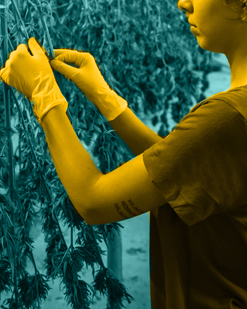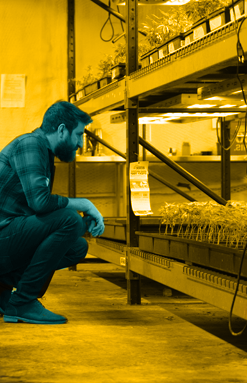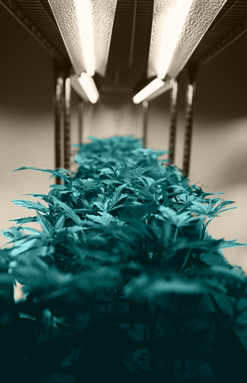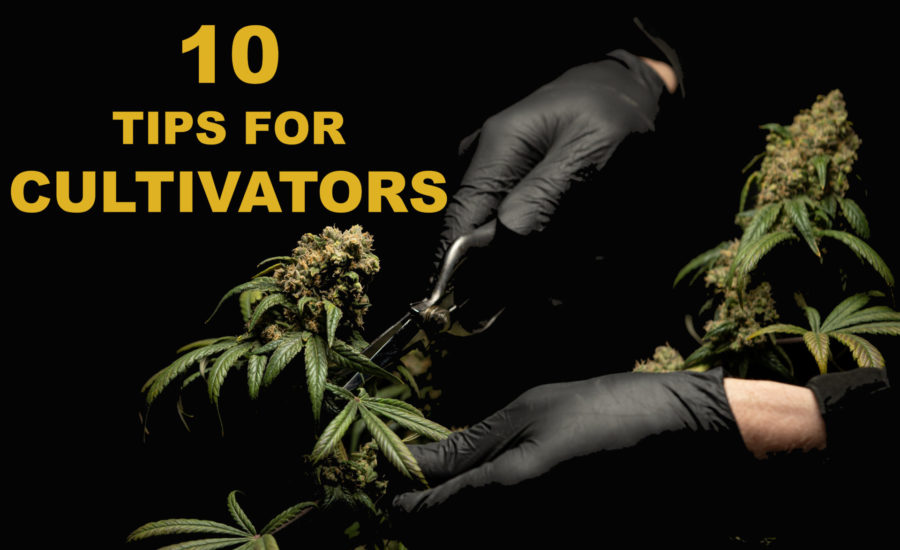There’s no doubt that the COVID-19 pandemic has thrown us all for a loop. During times like these, we are all just trying to survive and come out the other side intact. The current crisis has driven individuals and industries to innovate and be more agile. To conserve energy and increase efficiency. To simply stay in business. The cannabis industry is no different; even though most places declared cannabis as an essential business, many companies are struggling to survive…if they weren’t already. Now more than ever, as emergency guidelines and regulations continue to change and evolve, maintaining operational compliance has become even more complicated and confusing — regardless of where in the supply chain your licensed operation falls.
In an effort to make things at least a little more manageable, we are continuing our Compliance Tips blog series with these Top 10 Compliance Tips for Cultivators. Our team of industry regulatory experts is here to help cannabis businesses refocus in a time when distraction and anxiety are high, and prioritizing is difficult. If implemented, these tips can help cultivators stay ahead of the ever-changing regulations and maintain compliance as efficiently as possible.
Cannabis Compliance Tip #1: Know your Rules and your Regulators
- Break it down
- Build relationships
- Anticipate what’s coming
- Ask the right questions
- Prepare for an inspection
Operational compliance in the cannabis industry is layered with hundreds, if not thousands of rules, regulations, statutes, and codes to sort through. From international fire and building codes to guidelines from OSHA, the FDA, and EPA, to state and local cannabis-specific industry regulations…it can be overwhelming in more ways than one. If we’re going to succeed and enjoy it along the way, we need to foster a culture of compliance within our businesses and create layers of knowledge.
 Building strong relationships with regulators and enforcement can mean the difference between being open and closed. Find out which local law enforcement officers are assigned to oversee cannabis enforcement; that includes police officers, fire marshals, and building officials. Reach out to them and ask them what you can do as an operator to remain compliant. Know your resources. Is there an email blast group that you can get on? Who do you email if you have non-liability related questions? Do they offer training, informational sessions, or instructional walk-throughs? The enforcement team is typically learning just as much as operators. Being proactive and cooperative can go a long way toward developing beneficial relationships.
Building strong relationships with regulators and enforcement can mean the difference between being open and closed. Find out which local law enforcement officers are assigned to oversee cannabis enforcement; that includes police officers, fire marshals, and building officials. Reach out to them and ask them what you can do as an operator to remain compliant. Know your resources. Is there an email blast group that you can get on? Who do you email if you have non-liability related questions? Do they offer training, informational sessions, or instructional walk-throughs? The enforcement team is typically learning just as much as operators. Being proactive and cooperative can go a long way toward developing beneficial relationships.
Demonstrate your understanding of the regulations and find ways to show them you are compliant. Anticipate what’s coming next. Stay ahead of the curve of compliance. Just because they haven’t started to check for certain requirements under the regulation doesn’t mean they won’t eventually. Make sure you are prepared for a shift in approach and enforcement; operators and regulators alike are growing into this industry together.
Define your process for compliance communication, spot-checks, and asking for assistance interpreting the regulations. When it comes down to asking regulation interpretation questions, be sure to establish the who, what, and when. When do you take the question to your manager? To legal counsel? To a regulator? Who has that permission? If you have questions regarding regulations, it’s best to ask those questions prior to implementation.
What better way to prepare, than to practice? Identify your potential risk areas, audit your operation, and prioritize your remedies based on the level of the violation; public safety, operational, or administrative. Prepare your team by training your upper-level employees on the basics of regulations and communicating with enforcement officials, and by ensuring your front-line staff are competent with basic licensee requirements. Remind employees to respect the inspectors, let them in, and ask them to wait for a manager to escort them. Start small and do spot-checks once a week until you have a good grasp on the full scope of your operational compliance requirements. Then, establish consistency with daily, weekly, and monthly checks. This will help you to operate in a constant state of compliance, stay calm, and be prepared for an inspection at any time.
Cannabis Compliance Tip #2: Make Safety a Priority
- Job hazard analysis
- Workplace safety
- Chemical safety
In terms of safety, the Occupational Safety and Health Administration (OSHA) is the oversight organization for all businesses across all industries. The top five OSHA violations for cannabis business are regarding signage, a hazard communication plan, fire prevention plans, and providing proper personal protective equipment (PPE) for employees. OSHA offers a free On-Site Consultation Program, through which they provide confidential safety and occupational health advice that are separate from enforcement and do not result in fines or penalties. Even though OSHA isn’t currently coming into cannabis businesses without a complaint, they likely soon will. Take the time to prepare.
Reach out to your insurance company and perform a Job Hazard Analysis of your processes to identify physical, chemical, biological, and other potential hazards. And check out your state Department of Public Health’s guidance on worker safety and health in the cannabis industry. The most common hazards in cultivation operations include slips, trips, and falls, potential water and electrical interactions indoors, repetitive-motion injuries, lighting, and exposure to molds, pesticides, and other various chemicals. Train your team on these hazards, how to identify, and remedy them to create a safe environment. Using your job hazard analysis, create a solid workplace safety plan that establishes a commitment to safety, identifying hazards, preventing and controlling hazards, and employee training.
 The Environmental Protection Agency (EPA) has been regulating pesticides since 1975. Cultivators have used pesticides to combat certain pests and pathogens for decades, including, myclobutanil and avermectin. These pesticides have been proven to be harmful for human consumption and employee exposure. It is important to check with your state’s regulatory body to ensure all the chemicals you are using are approved for use on cannabis.
The Environmental Protection Agency (EPA) has been regulating pesticides since 1975. Cultivators have used pesticides to combat certain pests and pathogens for decades, including, myclobutanil and avermectin. These pesticides have been proven to be harmful for human consumption and employee exposure. It is important to check with your state’s regulatory body to ensure all the chemicals you are using are approved for use on cannabis.
Every few years, new guidance is provided on what is safe regarding pesticides for workers and handlers. If you haven’t already, check out the How to Comply with WPS Manual, as it has specific details on how to be safe and compliant. Pesticide Use and Application logs need to be filled out with specific information and immediately following application. Warning signs stating re-entry and alerting workers to the chemicals is important for everyone’s safety. OSHA’s Hazard Communication Standard (HCS) requires a business that handles chemicals to understand and train their team on safety data sheets, hazard classifications, labels, and rights.
One of the most important tools you have regarding chemical use are Safety Data Sheets (SDS). As of June 1, 2015, a globally harmonized system of classification and labeling of chemicals (GHS) was created. SDS’s are now in a 16 section format that is more user-friendly and consistent to help provide handlers with information regarding handling, storage, first-aid measures, proper PPE, and hazard classifications. These documents are required to be kept on-site at all times and for years after their use and application. If a claim is filed with OSHA, or another organization, you need to have the SDS for that product on-hand. In addition, local fire departments want to know what you currently have in your facility that may be flammable or hazardous in the event of an emergency. These SDS’s can help keep you and your team prepared for chemical accidents.
Each state has specific pesticide use, storage, and application requirements that all pesticide handlers must follow. Reach out to your Department of Agriculture to learn more of what is expected of you. They likely have checklists that you can use to check your own compliance. As an example, check out the Oregon Dept of Agriculture pamphlet on cannabis and pesticides and Colorado State’s Commercial pesticide applicator inspection resource.
Cannabis Compliance Tip #3: Go Beyond Security Requirements
- Commercial locks
- Alarm systems and notifications
- Camera coverage
- Surveillance systems
- Digital security
Security is a top concern for all states with legal and regulated cannabis markets. How will you prevent unauthorized entrance, theft, and diversion? Check with your state and local requirements first and ask questions to fully understand the scope of what you need to have covered. At a minimum, most states require commercial locks, alarm systems, and surveillance systems. Security systems need to detect early, provide real-time notices, replay footage, be secure within itself, and be visible.
Alarm systems help to prevent unauthorized entry and include motion sensors, glass breaks, panic, holdup, and distress alarms that notify local law enforcement, and motion sensor lighting. Surveillance systems help to deter theft and diversion and include cameras and recording devices. When it comes to camera coverage, make sure you cover all entrances and exits, all room transfers, and any areas where cannabis is handled, stored, or disposed of. Make sure the quality of the camera is high resolution, has sufficient lighting, displays the date and time, and footage is recorded in real-time. Recording devices typically need to be able to store at least 30-60 days of footage. Check with your state and local requirements before purchasing your devices.
Don’t just do the minimum — go beyond the state and local requirements to ensure your facility and inventory areas are secure. Do a walk-through of your grounds and ask yourself: Where am I most vulnerable for break-in? Do I have sufficient lighting? Where are my blind-spots from cameras? Take notes and make adjustments. Then think about your security risks in other areas. Most companies keep all of their business records digitally. How will you protect your accounting, surveillance, inventory, procedural, and employment records to ensure they are secure? Find a third-party security company that has experience with regulated systems, understands local requirements, is invested in the cannabis industry, and gives you options.
Most break-ins and thefts typically involve insider help. That means making good hiring decisions, creating an environment of trust and honesty, maintaining regular inventory protocols, setting cash handling redundancies, instituting stricter visitor policies, and making your security visible are all part of the equation.
Cannabis Compliance Tip #4: Limit Cross-Contamination
- Sanitation protocols
- Storage
- Minimize cross-contamination
Cleaning, sanitation, and disinfection are all critical parts of creating a safe and healthy working environment. Employee hygiene, including washing hands between all activities, plays a significant part in preventing contamination of your product and grow areas. Discuss and implement necessary health and sanitation protocols, require agricultural uniforms and PPE, and establish additional requirements to ensure employees aren’t bringing pests or pathogens onto the premises.
Storing your cannabis in an efficient, clean, dry, and pest-free area is essential and required by 21 CFR 110 in manufacturing, packing, and holding human food. Depending on your state regulations, there are likely also requirements regarding properly maintaining all surfaces, grounds, equipment, employee hygiene, and storage areas.

For all growers — indoor, outdoor, or greenhouse — maintaining your ‘outside the grow’ space is almost as important, if not more, than your growing space. A significant amount of cross-contamination comes from the outdoor world infiltrating your secure and clean growing spaces. Regularly maintain the lawn, trees, and vegetation around your facilities.
Cross-contamination can come from other places as well. It can come from your soil, water, coco coir, nutrients, compost, and fertilizers. Think about what you use to clean your surfaces, your raw materials, and the last time you cleaned your ventilation system. Consider what other farms are nearby, what crops they have, what pesticides they may be spraying, and where possible drift could occur.
And remember, the most common local complaint for city governing bodies is cannabis odors causing a potential loss in property value, affecting neighbors, and just the blatant dislike for the smell or the regulation of the product itself. Verify that you have documented systems and measures in place to track your efforts and respond to complaints.
Cannabis Compliance Tip #5: Think Sustainability
- Sustainable practices
- Carbon footprint
- Water conservation
- Energy consumption
- Safe disposal
- Other industry guidance
It almost goes without saying that outdoor cultivation is more sustainable and has less impact on energy consumption, but a significant number of indoor cultivation facilities still exist across the country. Some of the cannabis cultivation energy ‘waste’ is due to strict regulations disallowing outdoor grows in many areas, packaging and labeling requirements, and combining cannabis waste with other wastes that are not compostable. There are plenty of things that the industry can do to be more energy efficient in indoor spaces, but sometimes the upfront costs are too high for businesses to shoulder. Although the perception of the green rush is booming, the truth for most businesses is that net profits are minimal.
So let’s focus on where we can help indoor cultivators. Can cannabis farming be sustainable? Of course, with the right resources. And in order to stay competitive, you’ll need to save and invest in your facility and equipment many times over as technology advances and oversight shifts its focus to sustainability, energy and water consumption, and your carbon footprint. This article touches on some of the ways you can improve your facility in a sustainable way, including water usage, lighting, and flooring materials. There are some easy and immediate ways that you can manage your electric peak load, optimize your load, and offset energy use, including, understanding your peak load, alternating your lights, and using more electricity overnight.
 Vertical farming has its pros and cons, but can allow for more sustainable practices. Not only are you able to maximize your space, but it can be more conducive to capturing and reusing your water. Lighting is another major component to consider. Over the years the debate over high-pressure sodium (HPS) 1000-watt bulbs vs light-emitting diodes (LEDs) for cannabis has continued…but there’s no debate on which uses less energy. The cannabis cultivation space has inspired incredible advancement in lighting technology since most of the growing is indoors due to regulatory restrictions. Using the right lights can not only decrease your energy and electrical use, but it may also increase your yields.
Vertical farming has its pros and cons, but can allow for more sustainable practices. Not only are you able to maximize your space, but it can be more conducive to capturing and reusing your water. Lighting is another major component to consider. Over the years the debate over high-pressure sodium (HPS) 1000-watt bulbs vs light-emitting diodes (LEDs) for cannabis has continued…but there’s no debate on which uses less energy. The cannabis cultivation space has inspired incredible advancement in lighting technology since most of the growing is indoors due to regulatory restrictions. Using the right lights can not only decrease your energy and electrical use, but it may also increase your yields.
Offsetting, conserving, investing in renewable energy, and reducing carbon emissions are difficult for operators considering the multiple barriers due to federal prohibition. Likely, the only way to offset indoor cultivation energy right now is through personal solar panels and local energy offset funds that are being created since many wind and solar farms still won’t take cannabis money.
Most states require you to render your cannabis waste as “unusable and unrecognizable.” Take the time to research your state’s rules on marijuana waste specifically, as well as your solid waste disposal, including which facilities are able to accept and dispose of this waste. Most states suggest grinding, chopping, melting, or mixing with non-consumable and non-marijuana waste to achieve this requirement. Incorrect disposal or rendering of waste can not only cost you a violation, it can also make you a target of theft and can put the industry image at risk. Check out these state samples of how to handle solid cannabis waste in Colorado and Michigan. Some states are even starting to allow cultivation facilities to use it as compost at your facility.
Consider what kind of hazardous waste you have at your facility and ensure you understand the federal and state regulations surrounding its storage, labeling, and disposal. In addition, make sure you know what’s required to ensure your wastewater is properly handled.
And remember, we can look to other industries for tips on how to grow more efficiently, effectively, and sustainably. Cannabis cultivation is not that different from other commercial agriculture. Here are some tips from the California Department of Fish and Wildlife.
Cannabis Compliance Tip #6: Take Steps to Maintain Good Crop Health
- Vet your suppliers
- Integrated pest management
- Crop maintenance
- Stay ahead of testing
Let’s start at the beginning: make sure your start-up crop (seeds and clones) are healthy and come from a reliable source. Vet all your suppliers and distributors and ask questions about the products you are bringing into your facility, cannabis or otherwise. Determine if you would rather start from seed or clone. Typically, if you want to avoid genetic health issues within your crop, starting from seed is likely a safer bet. Once you have your crop started though, and you know what your plants are doing, starting from clone can be more efficient.
All cultivators struggle with environmental controls, consistent crop success, and optimizing plant growth. Accounting for all the ways the crop could fail is overwhelming. There are insurance companies that offer crop insurance. Make sure you consider your business’s greatest risks, discuss with your CPA and legal counsel, consult with other industry players and associations, and use a broker to determine what coverage is right for you?
 Daily scouting checks are essential to confirm your crops are healthy and free of pests, pathogens, and molds. Preparation and prevention are always better than reacting and responding. Understanding optimal growing conditions are necessary, and monitoring, documenting, and regulating your temperatures, humidity, and ventilation in indoor facilities are key. Make sure your ventilation and exhaust system are up to standards and ensure negative pressure in your facility. Environmental controls can help to keep your crop from all the killers – pests, pathogens, molds, rot, etc. Controlling airflow and maintaining your canopy is extremely important for limiting mold growth and pest infestations. Investing in HEPA filtered air systems and having strict cross-contamination protocols can help your facility and crop stay clean.
Daily scouting checks are essential to confirm your crops are healthy and free of pests, pathogens, and molds. Preparation and prevention are always better than reacting and responding. Understanding optimal growing conditions are necessary, and monitoring, documenting, and regulating your temperatures, humidity, and ventilation in indoor facilities are key. Make sure your ventilation and exhaust system are up to standards and ensure negative pressure in your facility. Environmental controls can help to keep your crop from all the killers – pests, pathogens, molds, rot, etc. Controlling airflow and maintaining your canopy is extremely important for limiting mold growth and pest infestations. Investing in HEPA filtered air systems and having strict cross-contamination protocols can help your facility and crop stay clean.
If you haven’t already, take a good look into Integrated Pest Management (IPM). IPM is an essential strategy used by commercial agriculture growers with specific protocols to prevent pest outbreaks by using the life cycles of the pest in a certain environment to identify, manage, and eliminate them before the outbreak becomes too large to control. By Implementing IPM protocols, it shows that you are being proactive about the health and safety of your product, your team, your facility, and your community. Outbreaks of pests can be significantly damaging at a large scale if they begin to spread.
Understanding how plants grow, the different phases of growth in cannabis, and the ideal environment for them will help you to keep your crop healthy. Crop maintenance involves canopy management, checking pH, nutrient levels, and electrical conductivity. It’s also important to consider flushing your product before harvest, as well as establishing more robust drying and curing procedures. Stay on top of your metrics and you’ll have your plants talking to you in no time.
Another important step in caring for your inventory is testing. Stay up to date on what your state requires for testing, including action limits. And be aware of cannabis news in regard to health and safety; Colorado’s Department of Revenue Marijuana Enforcement Division published their annual report from 2019 and stated that just under 20% of commercial cannabis flower, trim, and shake tested in 2019 failed microbial testing requirements.
Cannabis Compliance Tip #7: Focus on Detailed Inventory Management
- Seed to sale tracking
- Daily inventory audits
- Handle discrepancies immediately
Seed to sale tracking is required by every state that regulates cannabis in the country. Tracking and maintaining your inventory is one of the most important compliance functions as an operator. Get to know your state’s mandated tracking system and understand how your product moves through the process – clones, vegetative, flowering, harvest, drying/curing, storage, testing, and transfer. How will you maintain the organization of your inventory? How will you differentiate? Some of the biggest errors that occur in seed to sale tracking come from small mistakes and assumptions. And…there is no compliantly allowable amount of shrinkage for a federally illegal substance. You need to account for every seed, every clone, every plant, and every gram and unit.
One of the top infractions related to inventory is not reconciling on-premises and in-transit cannabis at the close of business every day. Daily reconciliations are not only required but can also prevent theft. Make sure to document your inventory audits to track your efforts to ensure inventory accuracy.
When it comes to handling discrepancies, timeliness is essential to efficient inventory control. Anyone that has found a discrepancy that hasn’t been touched for months understands how exponentially time-consuming it can be. If you handle it the moment you discover it exists, it is likely someone on your team can help to make heads or tails of it.
Cannabis Compliance Tip #8: Document, Document, Document
- Recordkeeping
- Standard Operating Procedures
- Storage
Good recordkeeping will not only keep you organized, but it will also help to show local and state regulators that you are maintaining compliance. This includes records for processes, licensing applications, inventory control, pesticide application, surveillance, employees, testing, transfers, transactions, financials and so much more. Make sure you invest in a secure document storage system that is organized and maintained in a way that you can find records easily in the event your agency requests them, and that it is secure from unauthorized access.
It can be difficult to put pen to paper, but we need to find a way. Standard Operating Procedures (SOPs) are the most useful tool for redundancy (security of your operations), task management (understanding workflows), agility (ever-changing regulations and market competition), and accountability (managed by a process). Documenting your processes is required by all states to varying degrees. Get started today if you haven’t already, and use these tools to create effective SOPs.
Cannabis Compliance Tip #9: Coach your Team
- Company culture
- Hiring and training
- Coaching
- Career Development
- Stitches not band-aid solutions
- Accountability
This goes beyond just developing a great employee training program. Although employee training is required, coaching your team by supporting, checking-in, and providing professional development opportunities, can really help to reinforce the training. Start by creating, developing, and reinforcing your mission, values, and company culture.
Create an employee handbook that lays out expectations, as well as essential compliance components and company policies. Ensure your employees sign the handbook, acknowledging that they read and understand it, in order to track accountability. Fine-tune your hiring and onboarding practices and cater your efforts around finding compliant employees that align with your company values. Conduct any required background checks and interviews to verify they’ll be a good fit. Then, break down your processes, document them, and create an employee training program. Focus your training on the following: cultivation practices, chemical use, safety, cross-contamination prevention, cannabis plant knowledge, and compliance requirements.
 As all good coaches know, training doesn’t end with the initial training session. Set up check-ins with your team to assess your training, as well as their performance and make sure to document them. Good SOPs can help to train people, provide clear expectations, lay out tasks, and make managing and coaching easier. They also allow for flexibility and immediate adjustments in an industry where it is essential, as things move and change fast. Many operators will say that a year in the cannabis industry is like three years in the ‘regular’ business world. Many companies (not just in cannabis) tend to implement band-aid solutions instead of fully cleaning, assessing, and stitching up the wound. Make updates to your processes and training materials when necessary and share those changes with your team. Check with your compliance team to understand which changes require notification to your oversight agency.
As all good coaches know, training doesn’t end with the initial training session. Set up check-ins with your team to assess your training, as well as their performance and make sure to document them. Good SOPs can help to train people, provide clear expectations, lay out tasks, and make managing and coaching easier. They also allow for flexibility and immediate adjustments in an industry where it is essential, as things move and change fast. Many operators will say that a year in the cannabis industry is like three years in the ‘regular’ business world. Many companies (not just in cannabis) tend to implement band-aid solutions instead of fully cleaning, assessing, and stitching up the wound. Make updates to your processes and training materials when necessary and share those changes with your team. Check with your compliance team to understand which changes require notification to your oversight agency.
Take care of your team by getting to know your employees, measuring metrics that matter, being transparent, and creating a path for growth. Think creatively about ways you can assist them in their professional development. If they know you care and are invested in their development, they are more likely to feel empowered to take care of the product and maintain compliance. In addition, stay abreast to evolving labor laws to ensure you stay compliant with national requirements.
Accountability is the biggest tool you have to confirm productivity and accuracy, and it needs to be embedded into the culture to really work. If you have to force it, it’s too late. People want to show their value and make a difference, but they don’t want to be micro-managed. Trust them and give them something to be proud of, and they will continue to work for you and keep your operation compliant.
Cannabis Compliance Tip #10: Know and Track your Costs
- Maintain accounting ledgers
- Know your production costs
- Prepare and pay taxes
We can’t talk about cannabis challenges and compliance without touching on finances. If the underlying conversation of banking challenges and 280E taxes aren’t enough, since the pandemic started, small business loans have not been made accessible to either cannabis-touching businesses or ancillary companies. The financial implications and requirements are strict and must be followed in detail.
Businesses are required to keep their financials separate for each license, maintain (and often submit) an accounting ledger, make regular payments on their federal 280E taxes, make monthly excise tax payments (to both local and state agencies, based on how much they transfer), and maintain a certain level of liability insurance. Check with your local and state regulations to determine what is required and make sure you meet at least the minimum requirements.
From a typical business perspective, understanding your financials, production costs, and overhead is instrumental. The importance of proper accounting for cannabis businesses is even greater for several reasons: audits, valuations, banking, insurance, and oversight. There is clearly a magnifying glass on the cannabis books to ensure money-laundering and diversion aren’t happening, and that all taxes are being paid in full. Most companies have experienced an audit of some form and anyone thinking of making it big needs to understand their valuation.
Production costs are essential to understanding the efficiency and sustainability of your business. Break down your costs by raw materials, distribution costs, excise taxes, and labor. Run time trials to confirm your true costs and find ways to make your processes more efficient.
On average, cannabis businesses pay an effective tax rate of 70% and they’re paying taxes on gross profits, rather than net profits. That, along with all the other overhead and state and local taxes, can render a business unprofitable. Make sure you hire a knowledgeable CPA who knows about the latest cases and precedents set when it comes to 280E filing.
Cultivator Cannabis Compliance
 The expectations for compliance is a moving target, ever-evolving and can vary widely from state to state. In order to not only survive, but succeed, you’ll need to implement agile processes, thoughtful decision-making, and a focus on people, quality, financials, and compliance.
The expectations for compliance is a moving target, ever-evolving and can vary widely from state to state. In order to not only survive, but succeed, you’ll need to implement agile processes, thoughtful decision-making, and a focus on people, quality, financials, and compliance.
Cultivation is the literal foundation of the cannabis industry; without the plant, there is no industry. Some say cannabis cultivation is a race to the bottom. The cost to produce cannabis per pound varies from state to state and will continue to fluctuate until federal legalization. This underscores the importance of understanding and watching cannabis markets, reflecting on your processes, and determining how much you can invest in your facility and your processes. And, who knows what long term effect coronavirus will have on the industry.
We not only want you to be prepared for regulatory inspections, we want you to feel confident and secure within your businesses. Our goal in all cannabis endeavors is to continue to redefine cannabis through maintaining compliance across a variety of subjects. It’s not easy, but we’re up for the task!
We hope you have enjoyed these compliance tips for cultivators. For more compliance tips, check out our blog on the Top Eight Compliance Tips for Cannabis Businesses for a basic overview and our Top Five Cannabis Compliance Tips for Retailers blog for retail-specific tips.
